Accelerate Productivity in 2025
Reignite Growth Despite the Global Slowdown
The world economy is crawling along at 2.8% growth in 2025 – the weakest five‑year stretch in three decades. At the same time, labor productivity growth in many advanced economies has turned negative.
Further, add a century‑high 22.5 % average U.S. tariff rate, chronically low private‑investment levels, and a slowdown in technological progress. The result is a sustained drag on corporate margins, wages, and fiscal space.
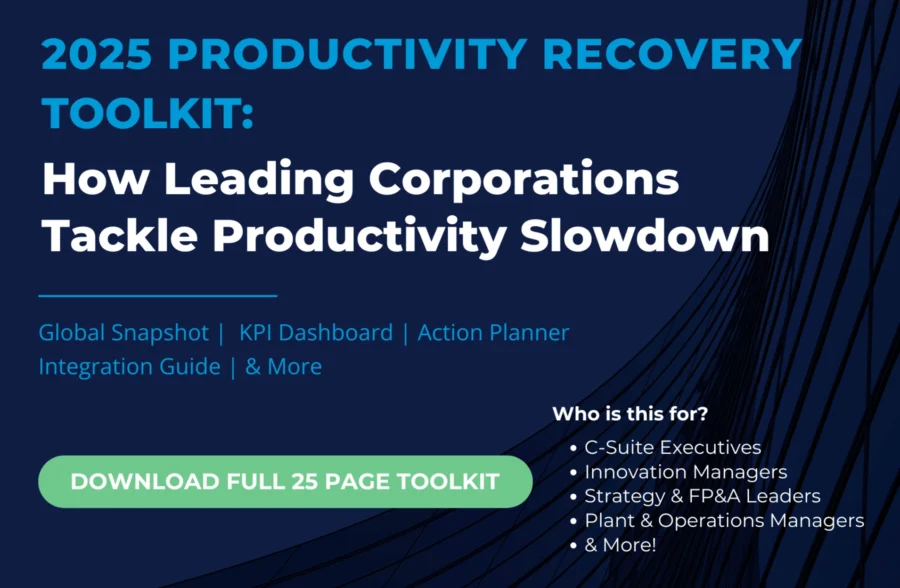
In this guide to tackle global productivity and economic slowdown, you will explore:
- State of Global Productivity & Economy in 2025
- Quick ROI Strategies & Innovations to Tackle the Slump
- Long-Term Strategies for Sustained Growth
- Regional Trends & Impact
- Metrics to Watch
- A Phased Roadmap
These insights allow you to go beyond speculative diagnoses and develop a data-backed, practical road map for reviving growth in your business.
Executive Snapshot – State of Productivity & Economy in 2025
Global growth is limping at just 3.3% through 2025, labor productivity is barely positive in most G‑7 economies, and private‑sector investment and cross‑border FDI are retreating.
Further, the average US tariff rate has rocketed to a century high of 22.5%. Together, these forces define the “productivity plateau” that executives must now navigate. Below is a data-packed snapshot.
1. Global Growth Pulse
According to the IMF, global growth is projected to slow to 2.8% in 2025, down from last year’s 3.3%. This deceleration is primarily attributed to escalating trade tensions and heightened policy uncertainty.
Advanced economies are expected to experience a modest slowdown, with growth projected at 1.4% in 2025. Emerging markets and developing economies (EMDEs) are anticipated to see growth decline to 3.7%. The IMF notes that inflation is expected to decrease more slowly than previously forecasted.
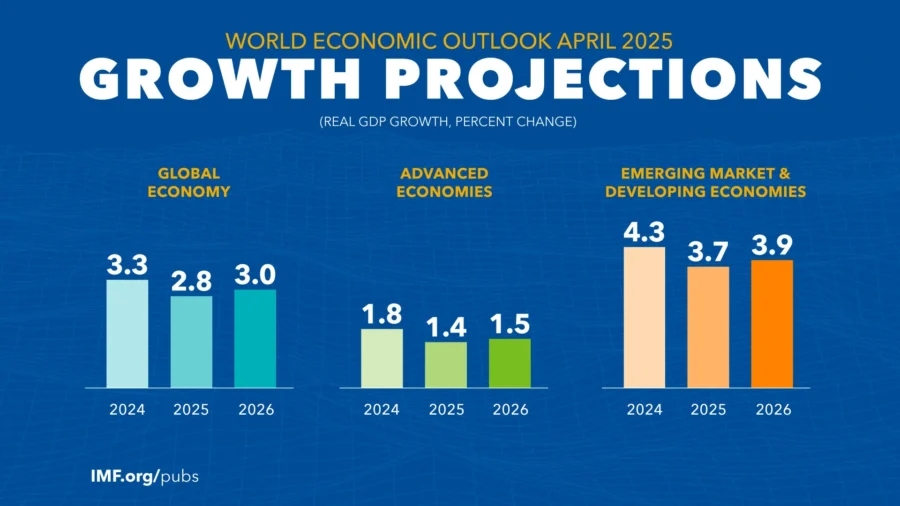
Source: IMF
2. Labor‑Productivity Reality Check
GDP per hour worked declined in 2022 across the US, the Euro area, and the OECD aggregate. According to the OECD’s 2023 Productivity Outlook, this was the first time in over a decade that all three major economic zones went through simultaneous productivity contraction.
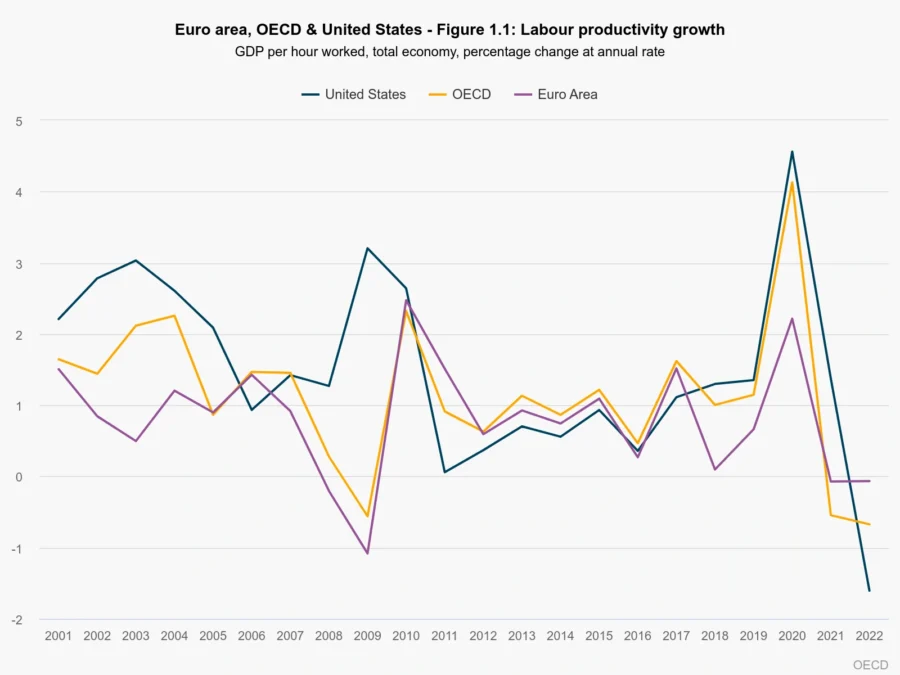
Source: OECD
Preliminary estimates from OECD Stat (Q1 2024) suggest that G‑7 economies are now averaging below 1% labor productivity growth. Japan, Italy, and the UK have seen flat to negative changes in output per hour worked, while the US shows rebounds largely driven by tech and professional services.
According to the International Labor Organization, employment growth in Sub-Saharan Africa is outpacing labor force gains, while in Northern Africa, the opposite is true, indicating unequal productivity pressures.
3. Investment & Capital Deepening
Capex slump: According to Deloitte, total corporate investment has increased by just 0.6% since 2020. This is significantly less than pre-pandemic norms.
Foreign Direct Investment (FDI) retreat: According to UNCTAD, worldwide FDI flows decreased by 2% in 2024, with developing nations experiencing a more severe decline of 7%, which hampered financing infrastructure projects.
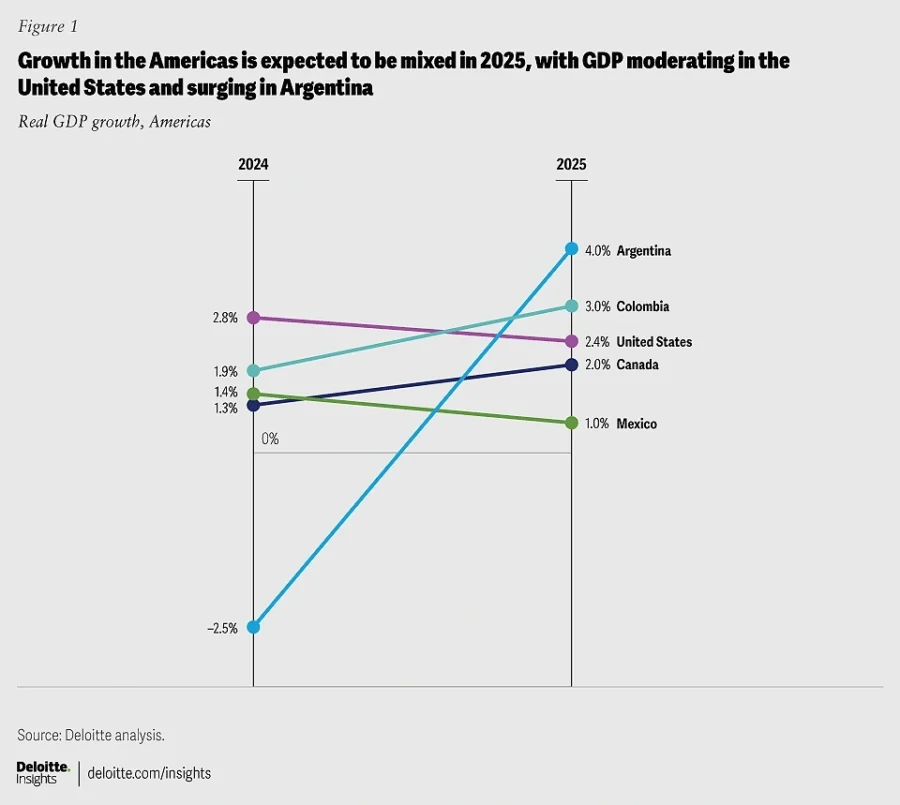
Source: Deloitte
4. Trade‑Policy Shock
Tariff spike: The average effective rate rises to 22.5%, the highest since 1909, when the 2025 rounds of U.S. charges are combined.
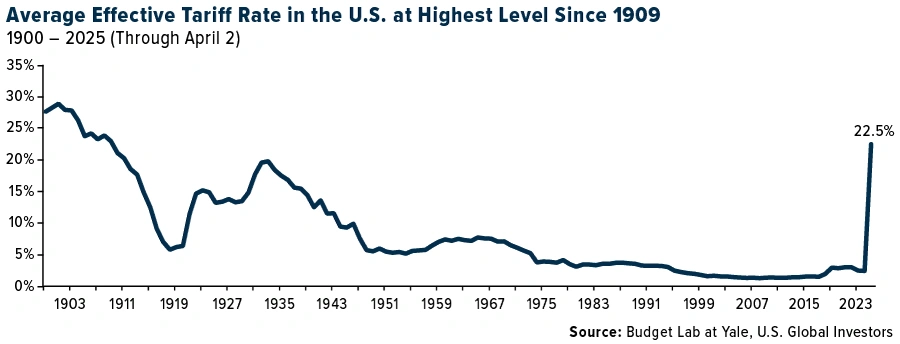
Source: U.S. Global Investors
Growth hit: According to IMF projections, the April tariff wave alone will cut the US GDP by 0.9 percentage points in 2025 and slow the expansion of global commerce to 1.7%.
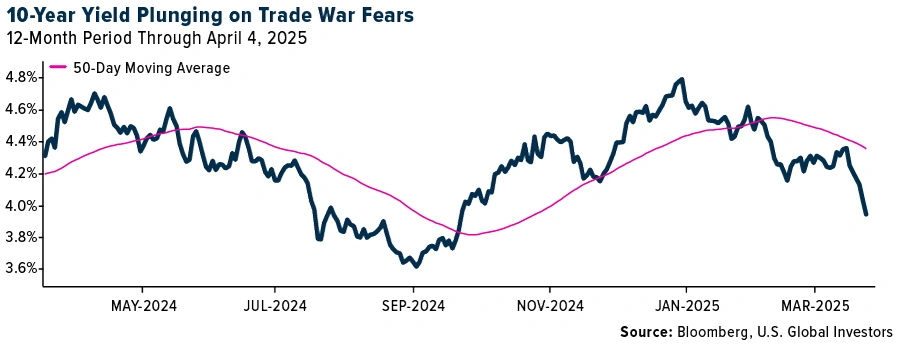
Source: US Global Investors
5. Technology Diffusion & AI Upside
Digital ‘pause’: IMF working papers attribute Europe’s productivity decline to lower business capacities and a slow adoption of digital technology.
Generative‑AI kicker: According to McKinsey, when fully scaled, Gen AI may realize USD 2.6-4.4 trillion in value and increase labor productivity by 0.1-0.6 points per year.
6. Demographic Drag
Ageing effect: Advanced economies’ per capita GDP could drop by about 8% over the next 30 years if policy changes are not made.
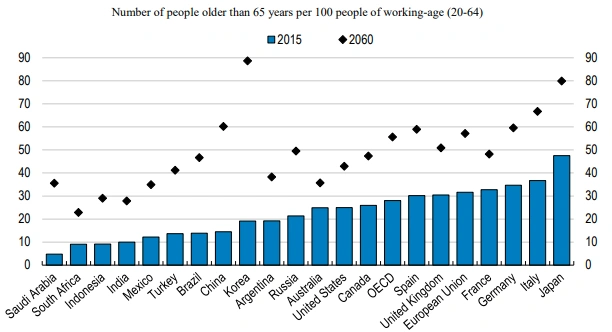
Source: OECD
7 Quick‑ROI Strategies and Innovations to Tackle the Slump (<1-Year Horizon)

You may also like:
1. Streamline Operations and Cut Unnecessary Costs
Industry recessions favor firms that reduce waste while safeguarding long‑term capabilities. A recent Harvard Business Review (HBR) analysis finds that companies combining disciplined cost cuts with process redesign benefit from the strongest margin rebounds in the recovery phase.
Lean initiatives based on automation also accelerate the effect: an HBR research shows that workflow automation cuts decision‑cycle time and boosts profitability in customer-facing functions.
On the revenue side, McKinsey finds sales-process automation alone can reduce administrative workload and lower selling costs enough to improve operating profit in under a year.
Action Checklist
Quarterly Process Mapping
Map end‑to‑end processes quarterly, flagging steps that fail to add customer value.
Eliminate or Automate Low-Value Activities
Avoid, simplify, or automate each low‑value activity and reinvest 10‑15 % of the savings in analytics for continuous monitoring.
Optimize Working Capital
Tighten working‑capital loops by synchronising payables and receivables dashboards.
2. Deploy Generative AI at the Point of Work
Economic Upside
McKinsey research estimates that generative AI applications could generate between USD 2.6 trillion and USD 4.4 trillion in annual global economic value. This represents a 15-40% increase beyond the value already expected from other AI technologies.
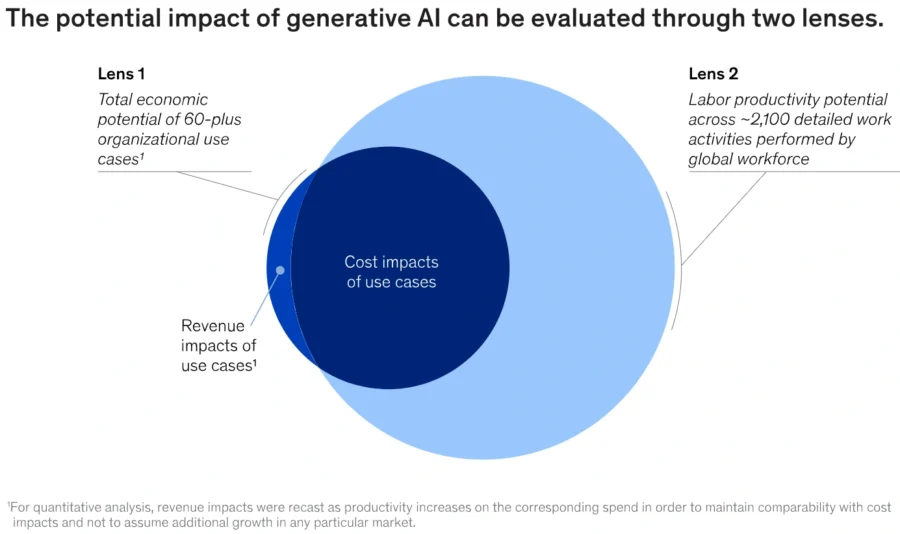
Source: McKinsey
Apart from immediate economic gains, generative AI is expected to drive substantial labor productivity improvements. When fully scaled, generative AI could increase labor productivity growth by 0.1-0.6 percentage points annually through 2040.
Early Gains
- Microsoft finds developers using GitHub Copilot complete coding tasks 55 % faster.
- Beyond speed, 85% of developers report increased confidence in their code quality when using Copilot
- AI assistance increased worker productivity in customer service by 15% on average, as measured by issues resolved per hour.
- An MIT-Stanford field experiment in a Fortune 500 call center logged a 14% jump in issues solved per hour, with 35 % gains for new agents.
- Deloitte’s 2024 enterprise survey shows 74% of firms hit or exceed ROI expectations for Gen‑AI pilots, many within the first year.
- In procurement specifically, BCG found that AI-enabled functions reduce overall costs by 15-45% while eliminating up to 30% of employee workload. This productivity boost allows organizations to redirect human talent toward more strategic, value-adding activities.
Action Checklist
Target High-Volume, Knowledge-Dense Workflows
Knowledge worker activities represent the greatest automation potential. A study estimates that 60-70% of knowledge worker time can be automated using genAI.
Pair Technology With Skills Development
Evidence consistently shows that less experienced and lower-skilled workers gain the most from AI assistance. This suggests targeted training for these groups will maximize returns.
Track Lead Indicators Before Direct Cost Benefits
Key metrics from successful implementations include throughput per worker, like issues resolved per hour and pull requests per week. Quality indicators like successful build rates, merge request acceptance, and customer satisfaction also provide balance to pure speed metrics.
3. Digitize & Automate Routine Workflows
Robotic Process Automation (RPA)
Median payback period for fully scaled RPA projects is approximately 12 months, with pilot initiatives often achieving breakeven within 9 months.
Additionally, Forrester’s Total Economic Impact (TEI) analysis of Microsoft Power Automate reveals that organizations realize a 223% ROI over three years, with initial investments recouped within 6 months.
These outcomes stem from RPA’s ability to automate 70–80% of rules-based processes. The manufacturing sector leads RPA adoption (35%), followed by technology (31%) and healthcare (10%).
Small Business Automation
According to Slack’s 2024 poll, owners may save three working weeks annually by automating calendar, invoicing, and messaging processes. This frees up 96 minutes each day.
National Benchmark: Estonia’s Digitalization-driven Productivity Leap
Estonia’s digital transformation strategy provides a macroeconomic blueprint for improving ROI in automation. OECD analysis reveals that a one-standard-deviation increase in digital adoption boosted firm-level productivity by 2.9% over three years.
Action Checklist
Target High-Impact Rules-Based Processes
Begin with functions where automation yields immediate FTE savings:
- Accounts Payable/Receivable: Automate invoice matching to reduce processing time from 15 days to 4 hours.
- HR Onboarding: Deploy chatbots that handle FAQs to reduce orientation costs.
- Expense Management: Automate employee expense validation against company policies and process reimbursements.
- Ticket Routing: Categorizing and assigning customer queries to the appropriate departments based on predefined rules.
- Order Processing: Automate the entry of orders into systems, inventory checks, and initiation of shipment processes.
Bundle Automation with Lean Process Redesign
PwC data shows that combining RPA and workflow optimization drives >30% cost reductions vs. isolated automation.
For example, an Asian e-commerce company redesigned inventory management alongside bot deployment to achieve a 10% gross margin growth using real-time demand forecasting.
Eliminate Shadow IT with Usage Analytics
A majority of organizations underestimate redundant workflows. By monitoring tool adoption rates and process completion times, organizations can decommission underused systems to recycle savings into AI augmentation. This boosts output per employee in call centers.
4. Tariff‑Proof & Shorten Supply Chains
Nearshoring Momentum Reaches Inflection Point
Kearney’s 2024 Reshoring Index reports that 96% of CEOs are considering or implementing reshoring strategies – a 15% year-over-year (YoY) increase. This surge is driven by three factors:
- Tariff Arbitrage: Average US import duties on Chinese goods reached 145% in early 2025, compared to 25% for USMCA partners.
- Risk Mitigation: 73% of companies have made changes in supply chain networks to improve redundancy in the past 2 years.
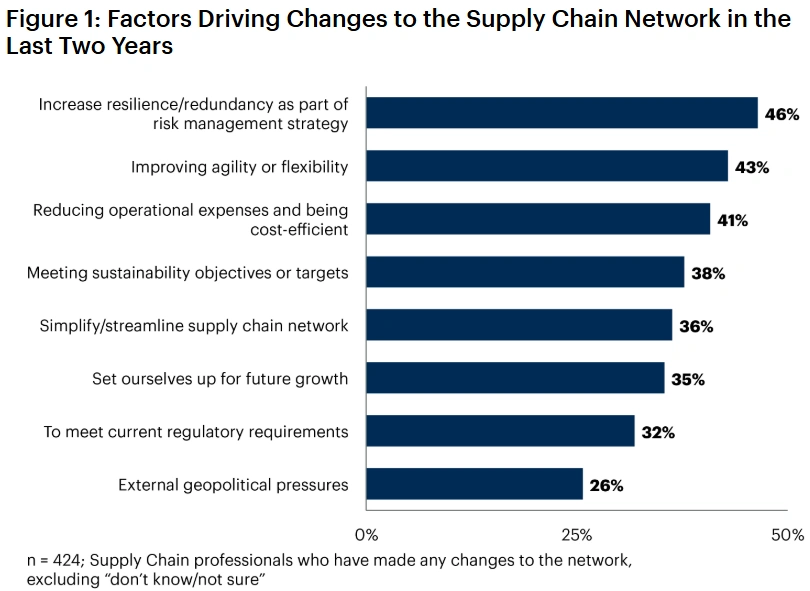
Source: Gartner
Case Study: Mexico’s Manufacturing Ecosystem
NovaLink’s cross-border operations show nearshoring’s financial and operational benefits:
Lead Time Compression
- Trans-Pacific ocean freight cycles: 42-58 days
- Mexico-to-U.S. ground transport: <10 days door-to-door.
- Inventory Reduction: Through just-in-time (JIT) replenishment cycles.
Cost Containment
- Tariff Avoidance: Savings via USMCA preferential treatment
- Logistics Cost Reduction: Lower per-unit freight costs vs. Asian imports
Action Checklist
Heat-Map Supply Chain Vulnerability
Conduct SKU-level analysis of:
- Harmonized Tariff Schedule exposure (current + projected)
- Tier-2 supplier geopolitical risk profiles
- Logistics choke points (customs, port congestion probabilities)
Pre-Secure Regional Capacity
Leverage hybrid contracting models.
- NAFTA: Reserve 20-30% capacity in Mexican manufacturing plants through take-or-pay agreements
- ASEAN: Maintain option contracts with Vietnam/Thailand manufacturers at a 5-7% premium
- Onshore: Negotiate surge capacity with domestic partners using cost-sharing clauses
Digitize Supplier Integration
Implement:
- Cloud-based EDI portals with auto-classification for rules of origin compliance
- AI-driven demand sensing that updates forecasts every 72 hours
- Blockchain-tracked inventory tagging for bonded warehouse optimization
5. Workforce Development and Education
The World Economic Forum’s Reskilling Revolution initiative is a critical response to address the talent crisis, as 85 million jobs are projected to remain vacant by 2030.
This initiative aims to equip 1 billion people with future-ready skills by 2030 through public-private partnerships. It has already reached 716 million individuals by early 2025.
Reskilling at Scale
- Sourcing Commitments: 35+ global CEOs and leaders pledge to reskill their workforces.
- Co-Creating Solutions: AI-powered skills mapping tools reduce training program development time.
- Connecting Ecosystems: National accelerators in 14 countries align education systems with industry needs.
Corporate Best Practices
AI-Driven Skills Audits
Annual workforce capability assessments using tools like PwC’s Skills Radar identify critical skill gaps quicker than traditional methods.
Implement Portable Credit Systems
Allocate a budget per employee annually for modular microcredentials.
Partner with platforms like Coursera and Gnowbe (bite-sized mobile learning) that report higher completion rates compared to traditional learning management systems.
Action Checklist
1. Conduct Dynamic Skills Audits
- Deploy AI tools analyzing job architecture data, project staffing patterns, and external talent benchmarks quarterly.
- Map results against WEF’s future skills taxonomy covering AI literacy, green tech, and cyber-physical systems.
2. Implement Portable Credit Systems
- Allocate a budget per employee for modular microcredentials annually.
3. Institutionalize Skills-Based Advancement
- Require 40 hours of certified learning annually for promotion eligibility.
- Embed skill demonstration into performance reviews.
6. Focus on Core Competencies and Customer Relationships
Economic downturns demand prioritization of competitive strengths and client relationships to stabilize revenue streams.
According to Investopedia, businesses that optimize cash flow, refine loyalty programs, and deliver hyper-personalized services outperform peers during contractions.
Core Competency Optimization
Companies narrowing their focus to high-margin, differentiated offerings achieve higher customer retention rates than diversified peers. For example:
- Software firms with unprofitable product lines should reallocate saved R&D budgets to core platform enhancements. This will drive average revenue per user (ARPU) growth despite market headwinds.
- Manufacturers doubling down on proprietary technologies will reduce SKUs while improving gross margins.
Customer Retention
Bain & Company research confirms that 5% improvements in customer retention yield more than 25% profit growth due to reduced acquisition costs and increased lifetime value. Successful programs share three traits:
- Predictive Loyalty Tiers: Effective programs utilize data analytics to segment customers into tiers based on behavior and value. This enables tailored experiences for enhanced engagement and profitability.
- Tailored Service Models: Personalized service delivery, informed by customer preferences and behaviors, fosters deeper relationships.
- Emotional Brand Connections: Consistent, value-driven interactions strengthen customer bonds. Brands that resonate on an emotional level often see increased advocacy and repeat business.
Action Checklist
1. Implement Granular Customer Lifetime Value (CLV) Segmentation
- Deploy tools like Klaviyo’s analytics to score accounts based on historic spend, engagement frequency, and product affinity.
- Allocate service resources proportionally: Top-tier clients receive dedicated account managers, while automated solutions serve lower tiers.
2. Build Closed-Loop Feedback Systems
Integrate net promoter score (NPS) surveys with customer relationship management (CRM) platforms to trigger intervention workflows for detractors quickly.
Analyze verbatim feedback using large language models (LLMs) to identify process gaps.
3. Optimize Retention Marketing Mix
Shift 55–60% of budgets from acquisition to proven retention channels:
- Loyalty apps with geo-targeted offers
- Win-back campaigns for dormant accounts
- Subscription models with usage-based pricing
7. Strengthen Financial Health and Diversify Revenue
HBR recession studies show companies that trim discretionary spend, restructure debt early, and add counter‑cyclical revenue streams outperform peers post‑recession. Diversification into adjacent digital services can stabilise cash flows and exploit existing capabilities.
Diversification: Digital and Adjacent Opportunities
Diversifying into adjacent digital services or new product lines stabilizes revenue while leveraging existing capabilities.
For example, Adobe, Nike, and Disney have expanded into digital subscriptions, direct-to-consumer (DTC) platforms, and streaming services to ensure recurring revenue streams. This allows them to mitigate cyclical declines in their core markets.
Diversification thus reduces dependency on a single market, protects against industry-specific shocks, and enables access to faster-growing segments. However, it demands careful market research, disciplined execution, and a focus on synergies.
Financial Management: Liquidity and Resilience
Effective financial management is crucial for sustainable operations during a downturn. Maintaining a liquidity buffer – commonly set at 20% of operating expenses – enables companies to navigate cash flow disruptions without resorting to costly emergency financing.
Further, regular debt-stress testing allows businesses to identify vulnerabilities and ensure timely restructuring. This minimizes risk from rising interest rates or tightening credit conditions.
Action Checklist
Conduct Quarterly Debt-Stress Tests
Simulate adverse scenarios to assess the impact on cash flow and debt service capacity. Adjust capital structure proactively if needed.
Set a 20% Liquidity Buffer
Maintain cash or near-cash reserves equivalent to at least 20% of annual operating expenses to ensure resilience during revenue shocks.
Pilot New Product Lines
Launch at least one offering or adjacent service each year. Start with small-scale pilots, gather customer feedback, and iterate quickly to build new revenue streams.
Trim Non-Essential Spends
Review all non-essential expenses and delay or eliminate low-ROI projects to preserve capital for strategic investments.
Monitor and Optimize Cash Flow
Tighten receivables, renegotiate supplier terms, and automate invoicing to reduce Days Sales Outstanding and improve working capital.
4 Strategies for Structural Growth (3 to 10‑Year Horizon)

1. Scale Intangible & Digital Capital
Intangible and digital assets – software, data, brands, algorithms, patents – now create most of the economic value in advanced economies. WIPO reports that intangible asset investment has grown three times faster than tangible capex over the past 15 years.
Companies that out‑invest peers in intangibles deliver 2.6× higher growth and superior productivity gains.
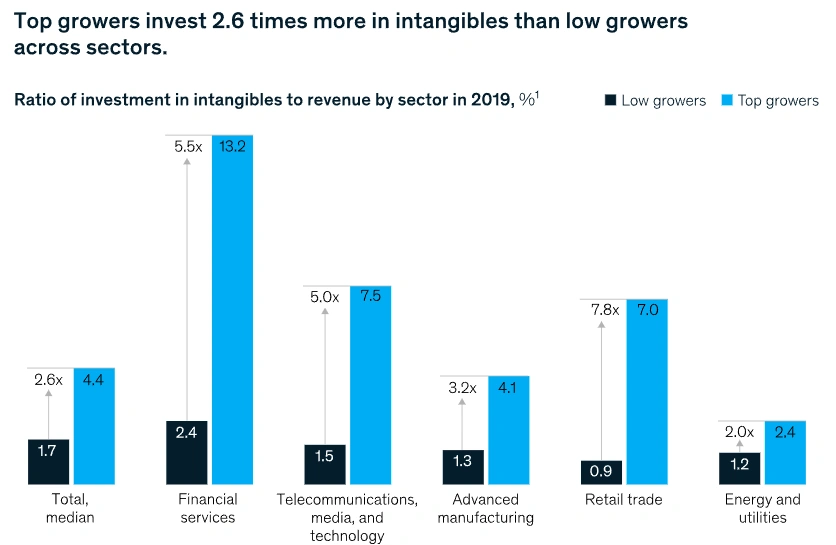
Source: McKinsey
Capitalise Data, Software & Algorithms
- IAS 38 allows capitalization of internally generated software if future economic benefits are probable. Emerging practice extends the logic to machine learning models and curated data sets.
- OECD’s experimental framework recommends recording data acquisition, cleaning, and labelling costs as investment to properly reflect value creation oecd.org.
- Action: Establish a “Digital Asset Register” that logs cost, useful life, and impairment triggers for each data/model asset.
Lift Intangible Capex to 12 ‑ 15 % of Revenue
- Leaders like Apple plan to spend more than USD 500 billion over four years on AI silicon and skills, which is more than most physical‑plant budgets.
- Boards should also benchmark R&D + software + data spend against revenue: top-quartile innovators cluster above 12%.
Fund Through Specialised Vehicles
- Venture funding for intangible‑intensive startups is rebounding – global corporate-venture-capital (CVC) flows rose to USD 185.1 billion in 2024.
- Tap IP‑backed lending and “data‑asset securitization” to reduce the cost of capital for R&D.
Implementation Roadmap
2. Embed AI‑First Product & Process Innovation
Companies implementing generative, predictive, and decision-automation models across product design and core processes reduce time-to-market. This also improves labor productivity and unlocks cost take-outs that finance the next wave of innovation.
Strategic Rationale – Why Go AI-First?
- Digital and AI “core” investments correlate with up to 60% higher revenue growth and a 40% profit lift according to Accenture.
- Further, OECD reports that economy-wide adoption could push sector-level productivity growth 0.4-0.9 pp higher.
Proof Points from Early Movers
- A Stanford-MIT field experiment in a Fortune 500 call center logged a 14% jump in issues resolved per hour, with the biggest gains (35%) among new agents.
- Deloitte’s report finds 74% of enterprises have already met or exceeded ROI targets on pilot projects.
- Despite growing pains, 54% of executives still expect at least 10% cost savings from Gen-AI rollouts, according to BCG’s latest survey.
Operating Model
1. Standardize the Production Line
Harvard Business School’s “AI Factory” concept codifies how companies convert raw data into predictions, decisions, and learning loops at an industrial scale. Core components:
2. Inject AI into Every Stage of Product Development
- Simulation tools such as Ansys SimAI accelerate computational fluid dynamics (CFD) analysis from days to minutes. This reduces design iterations and launch cycles.
- Gartner’s AI Hype Cycle positions domain-specific Gen-AI and AutoML on the “Slope of Enlightenment,” signalling imminent mainstream adoption.
Implementation Roadmap (0-5 Years)
3. Supercharge Corporate Venturing & Open‑Innovation Ecosystems
Despite the current dip in venture appetite, corporate venturing remains one of the few innovation strategies with a structural-rather-than-cyclical payoff. Global CVC funding finished last year at USD 65.9 billion – up 20% from the depressed 2023 base.
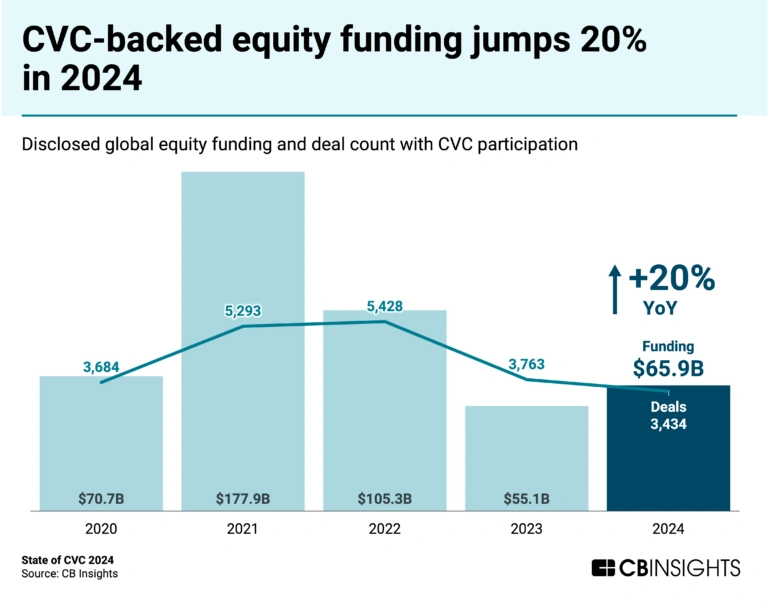
Source: CBInsights
In other words, the near-term trend may be choppy, but the long-run case for tapping external invention, speed, and optionality is stronger.
Macroeconomic Reality Check
Your Radar in Volatile Markets: StartUs Insights’ Discovery Platform
Long-Term Playbook for Supercharging CVC & Open Innovation
1. Lock in a 10-Year Capital Envelope
- Target 1-1.5% of sales for CVC – even in downturn years – to avoid “start-stop” cycles that destroy credibility.
- Reserve 30% of that pool for option bets in farther-horizon tech (quantum, synthetic biology, etc).
2. Curate Open-Innovation Ecosystems
- Innovation Challenges: Publish annual problem statements; invite top-decile startups flagged by startup scouting platforms, like our Discovery Platform.
- Co-creation Hubs: Co-locate CVC analysts with BU “demand owners” to ensure post-investment adoption.
- Supplier & SME On-ramps: World Bank shows ecosystem participation lifts SME productivity and supply-chain resilience.
3. Blend Funding & Risk-Sharing Tools
- Leverage IP-backed lending and sovereign guarantees to stretch runways for intangible-heavy ventures.
- Use secondary VC markets to recycle capital from mature positions.
4. Unlock Finance & Policy Enablers for Innovation
Finance and policy are shifting toward knowledge assets. Today, tax incentives already supply 55% of all public support for business R&D across the OECD. Governments from Beijing to Brussels are issuing dedicated innovation bonds and green notes to crowd in private capital.
At the same time, new lending products treat patents, data sets, and algorithms as collateral.
Deploy Direct Funding & Blended Guarantees
The World Bank will triple annual guarantee issuance to USD 20 billion by 2030, simplifying access for technology projects in emerging markets. China’s new sci-tech innovation bond segment alone targets USD 41.46 billion for R&D-intensive issuers.
Action Points
- Combine sovereign or multilateral development banks (MDB) guarantees with private loans for cap-heavy deep-tech pilots.
- Issue green or innovation bonds to tap thematic ESG funds for compliant assets.
Unlock IP-Backed & Intangible-Asset Finance
WIPO’s 2024 “Unlocking IP-Backed Financing” series details country pilots – from the UK to Turkey – where banks lend against patent portfolios and trademarks. IAM Media reports that UK lenders NatWest and HSBC are already underwriting IP-collateralised loans for growth firms IAM MediaIAM Media.
Action Points
- Build an IP-valuation playbook aligned to WIPO/IVSC guidelines to satisfy lenders.
- Pool patents and copyrights into special-purpose vehicles to boost collateral value.
Implementation Checklist
Regional Diagnostics – Where the Drag Is Strongest
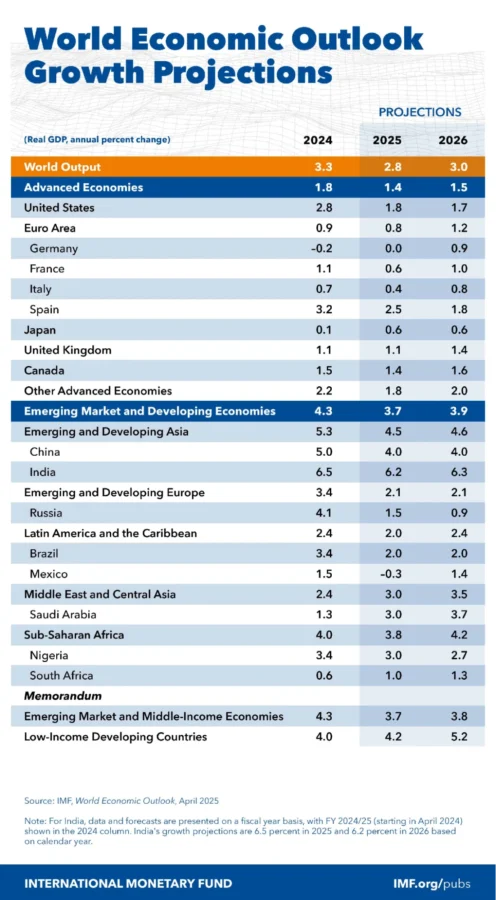
Source: IMF
The IMF projects global growth to decelerate to 2.8% in 2025, down from 3.3% in 2024, primarily due to heightened trade tensions and policy uncertainties.
- Advanced Economies: Growth is expected to slow to 1.4%, with the US forecasted at 1.8%, reflecting the impact of new tariffs and increased policy-induced uncertainty.
- Emerging and Developing Asia: Projected growth is 4.5%, a decline from previous estimates, due to the adverse effects of recent tariffs, particularly impacting ASEAN countries and China.
- China: Growth forecast revised down to 4.0% for 2025. This is influenced by the implementation of new tariffs and ongoing trade policy uncertainties.
- India: Maintains a relatively stable outlook with a projected growth of 6.2%, supported by strong private consumption, especially in rural areas.
- Latin America and the Caribbean: Growth is anticipated to moderate to 2.0%, affected by tighter financing conditions and reduced external demand.
- Emerging and Developing Europe: Expected to grow at 2.1%, with a notable slowdown in Russia due to decreased private consumption and investment.
- Sub-Saharan Africa: Projected growth of 3.8%, slightly down from 4.0% in 2024, as the region faces challenges from commodity price volatility and tightening global financial conditions.
Metrics to Watch – Turn Strategy into a Weekly Scorecard

A high‑impact execution playbook starts with metrics that matter assigns clear owners through a cross‑functional task force, secures catalytic financing, and sequences reforms so that quick wins fund the next wave of structural change.
Tip: Display these on a public dashboard; set red-amber-green thresholds that trigger quarterly course corrections.
Policy Sequencer – A Phased Roadmap (0-10 Years)
Bonus Execution Tips
- Front‑load credibility: Publish the dashboard and first project pipeline within 90 days to build stakeholder trust.
- Ring‑fence quick‑win savings: Redirect a slice of RPA/AI efficiency gains toward skills & infra funds.
- Keep a change‑log: Document policy tweaks and KPI shifts publicly; it boosts accountability and investor confidence.
- Communicate wins: Share MIT‑style AI success stories and early cost savings to maintain momentum.
Finding the Best Solution for Quick ROI
With thousands of emerging technologies and startups, navigating the right investment and partnership opportunities that bring returns quickly is challenging.
With access to over 7 million emerging companies and 20K+ technologies & trends globally, our AI and Big Data-powered Discovery Platform equips you with the actionable insights you need to stay ahead of the curve during this economic slowdown.
Leverage this powerful tool to spot the next big thing before it goes mainstream. Stay relevant, resilient, and ready for what is next.

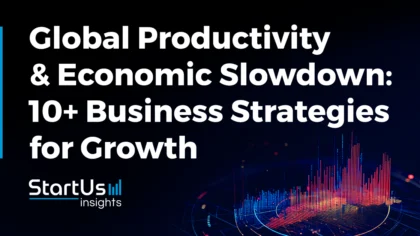

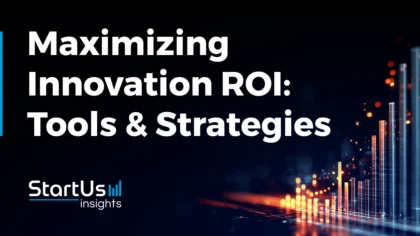

![Top 16 Future Technologies & How They Impact 40+ Industries [2026-2030]](https://www.startus-insights.com/wp-content/uploads/2024/06/Future-Technologies-SharedImg-StartUs-Insights-noresize-420x236.webp)



